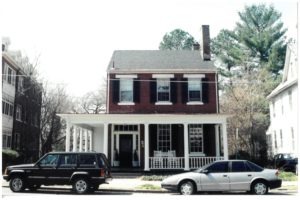Feature on Candlelight Tour House – 704 Prince Edward St
Feature on Candlelight Tour House – 704 Prince Edward St
Blog Post by Wendy Migdal
Principal Researcher: Roger Engels

The house at 704 Prince Edward Street, built in 1855, has been home to families large and small, some who were there for years and some for only a short while. But if walls could talk, one of their most outstanding memories would be the time an old Civil War veteran came back to the scene where he lost his arm 46 years earlier.
William Wright of New York was serving with Duryea’s Zouaves when he was wounded at the Battle of the Wilderness. The entire city of Fredericksburg had become essentially a hospital after the battle, and 704 Prince Edward was no exception. The Hirshes had bought the house only about a year earlier, in April 1863. Kaufman and Hannah Hirsh lived there with their seven children; three of their daughters helped nurse Wright back to health after his arm was amputated in their parlor.
In 1910, Wright returned to Fredericksburg for a visit. One of those daughters, Rosa, now married, was still living in the house with her husband. Either Wright had established a special friendship with the family while he was convalescing, or the wartime memories uniting people were strong, but a Free Lance-Star entry reports that he spent several days with the family.
For nearly 100 years, (1863–1958), three generations of Hirshes lived in the home—grandparents Kaufman and Hannah and their children, daughter Rosa who married Herman Kaufman (yes, her husband’s last name was the same as her father’s first), and grandson Sydney. One of the earliest Jewish families in Fredericksburg, the Hirshes were prominent merchants, owning several mercantile, grocery, and jewelry stores throughout the years.
When Rosa Hirsh Kaufman’s mother died in 1893 (her father had died in 1891), her six siblings agreed to sell their interest in the house to her. It appears that Rosa had been living there already because her father’s obituary stated that he died in Baltimore. In the early 1900s, the Kaufmans sold off some parcels of land behind the house that had been part of the property. These parcels became part of Hanover Park, where the Fredericksburg White Sox played for some years. The park also hosted traveling shows such as the Chautauqua and other amusement-type parks, until the G&H Corporation bought it and built a clothing factory. Today, the buildings are a mixed-use office and residential space called Mill Race Commons.
It was during Rosa’s residence that William Wright returned to visit the scene of what surely one of the most harrowing moments of his life. It was also during this time that some additions were made to the house. The Kaufmans extended the front porch to the full width of the house by 1912, according to Sanborn fire insurance maps, and built an addition to the kitchen as well as a shed. By 1919, they had added a garage in front of the shed and a frame addition at the rear of the two-story portion of the house. By 1927 (the year Rosa died), a second story had been added to the frame addition.
The house passed out of the Hirsh and Kaufman families’ hands when the widow of Sydney Kaufman (Rosa’s son) sold it in 1958.
For more information on the building of the home and other owners, stay tuned to this blog. This house will also be on the Candlelight Tour December 8 and 9, 2018. More to come on 704 Prince Edward Street soon!

Leave a Reply
Want to join the discussion?Feel free to contribute!